Keeping your car’s engine in top shape is key to its long life and performance. Changing the engine oil regularly is a must. This guide will walk you through the steps to change your engine oil. You’ll learn how to do it yourself, from the basics to the details.
It covers why oil changes are important, how to pick the right oil, and how to dispose of old oil safely. You’ll get all the info you need to take care of your car’s engine.
Key Takeaways
- Understand the importance of regular oil changes for your vehicle’s performance and longevity.
- Learn how to identify the signs that your car needs an oil change.
- Discover the cost benefits of performing DIY oil changes compared to professional services.
- Familiarize yourself with the essential tools and materials needed for an oil change.
- Explore the different types of engine oil and how to choose the right one for your vehicle.
Understanding the Importance of Regular Oil Changes
Keeping your vehicle in top shape is key to its long life and best performance. At the core of this is the need for regular oil changes. Engine oil is essential for your car’s engine to run smoothly and last longer.
How Engine Oil Affects Vehicle Performance
Engine oil keeps your car’s engine parts moving smoothly, reducing wear and tear. Over time, the oil gets less effective, causing your engine to work harder. This can lead to poor performance, less fuel efficiency, and even engine failure if not addressed.
Signs Your Car Needs an Oil Change
- Increased engine noise or knocking sounds
- Decreased acceleration or power
- Decreased fuel efficiency
- Dark, dirty, or thick engine oil
- Oil change indicator light illuminated on the dashboard
The Cost Benefits of DIY Oil Changes
Doing your own oil changes can save you money in the long run. With the right tools and a bit of knowledge, you can change your oil at home. This saves on labor costs and lets you keep a closer eye on your car’s engine health.
| Professional Oil Change | DIY Oil Change |
|---|---|
| $30 – $80 | $20 – $40 |
Knowing the importance of regular oil change frequency and the perks of DIY oil changes helps you maintain your vehicle’s engine performance. It also helps extend your car’s life.
Essential Tools and Materials Needed for an Oil Change
Changing your car’s engine oil is easy with the right tools. Whether you’re a DIY expert or new to oil changes, the right oil change tools are key. Let’s look at what you need to do the job right.
An oil filter wrench is a must for oil changes. It makes removing and installing the oil filter easy. Choose one that fits your car’s oil filter well.
You’ll also need an oil pan. It catches the old oil as it drains. Look for one with a wide mouth and a spout for easy pouring.
- Socket wrench set
- Torque wrench (for proper oil filter tightening)
- Gloves (to protect your hands)
- Rags or paper towels (for cleaning up spills)
- Jack and jack stands (if necessary to access the oil drain plug)
Consider getting specialized oil change tools too. Tools like an oil filter removal tool or a drain plug socket can make things easier. They’re great if you change your oil often.
| Tool | Purpose | Recommended Features |
|---|---|---|
| Oil Filter Wrench | Removing and installing the oil filter | Adjustable size, sturdy construction |
| Oil Pan | Catching and containing the old oil | Wide mouth, easy-pour spout |
| Socket Wrench Set | Loosening and tightening the oil drain plug | Comprehensive range of socket sizes |
| Torque Wrench | Ensuring the oil filter is properly tightened | Precise torque measurement |
With these oil change tools and materials, you’re ready for your next oil change. You’ll do it with confidence and efficiency.
Types of Engine Oil and How to Choose the Right One
Choosing the right engine oil is key to a smooth-running vehicle. It lubricates parts, protects against wear, improves fuel efficiency, and extends engine life. Let’s look at the different engine oils and how to pick the best one for your car.
Conventional vs. Synthetic Oil
Conventional oil is the traditional, mineral-based choice. It’s reliable and affordable but may not match synthetic oil’s performance. Synthetic oil, made for better lubrication and protection, is more advanced.
Understanding Oil Viscosity Ratings
- المحرك oil viscosity is measured on a scale, with lower numbers indicating thinner oil and higher numbers indicating thicker oil.
- The most common viscosity ratings are 0W-20, 5W-30, and 10W-30. The first number shows cold-weather performance, and the second shows hot-weather performance.
- Choosing the right viscosity is crucial. Using the wrong oil can harm fuel efficiency, increase wear, and even damage your engine.
Manufacturer Recommendations
Following the manufacturer’s recommendations is vital when picking engine oil. These can be found in your owner’s manual or on the manufacturer’s website. They ensure you choose the right oil for your engine’s needs, keeping it running well and lasting longer.
| Engine Oil Type | Viscosity Rating | Fuel Efficiency | Engine Protection |
|---|---|---|---|
| Conventional | 10W-30, 5W-30 | Average | Good |
| Synthetic | 0W-20, 5W-30 | Excellent | Exceptional |
“Choosing the right engine oil is essential for the longevity and performance of your vehicle. By understanding the differences between conventional and synthetic oil, as well as the importance of viscosity ratings and manufacturer recommendations, you can ensure your engine is properly lubricated and protected.”
Safety Precautions Before Starting the Oil Change
Changing your engine oil is a simple task, but safety is key. Before starting, make sure you take the right steps to stay safe. This will make the oil change smooth and worry-free.
Proper Vehicle Lifting
First, safely lift your vehicle. Use a good jack or hydraulic lift to get it to a good height. Never work under a car on a floor jack alone. Always use jack stands for extra safety.
Protective Gear
- Wear gloves to protect your hands from hot parts and fluids.
- Put on safety glasses to keep your eyes safe from splashes or debris.
- Wear coveralls or an apron to keep your clothes clean and oil-free.
Handling Hot Surfaces
Be careful with hot engine parts. Let the engine cool down before draining oil or removing the filter. Touching hot metal can cause burns, so check the temperature first.
| Safety Measure | Importance |
|---|---|
| Proper Vehicle Lifting | Ensures the vehicle is securely raised and stable during the oil change, preventing potential accidents or injuries. |
| Protective Gear | Safeguards against exposure to hot surfaces, splashes, and other hazards associated with the oil change process. |
| Caution with Hot Surfaces | Allows the engine to cool down, reducing the risk of burns and other thermal-related injuries. |
By taking these safety steps, you can do your vehicle’s oil change safely. This way, you avoid the risks that come with this routine task.
A Comprehensive Guide to Changing Your Engine Oil
Changing your engine oil is key to keeping your car running well. We’ll show you how to find the oil drain plug, take out the old oil filter, and dispose of the used oil correctly.
Locating the Oil Drain Plug
The first thing to do is find the oil drain plug. It’s usually at the oil pan’s bottom. This plug is metal and might need a wrench or socket to open. Check your car’s manual for where and how big it is.
Removing the Old Oil Filter
Then, you’ll remove the old oil filter. Use an oil filter wrench for this. Some filters are easy to get to, while others are harder. Be slow and careful to avoid spills.
Proper Disposal of Used Oil
After draining the oil and taking out the filter, dispose of the used oil right. Many auto stores and recycling centers take used oil. Don’t dump it down drains or on the ground. It’s bad for the environment. Follow local rules for used oil recycling.
By following these steps, you can change your engine oil well. Always check your owner’s manual for the right way and safety tips.
Installing the New Oil Filter Correctly
Changing your engine oil is a must, but installing the new oil filter right is key. The oil filter keeps your engine running smoothly by catching dirt and keeping it out of your car’s lubrication system. A tight, leak-free seal is essential for your engine to perform well and last longer.
Choosing the right oil filter for your car is important. Check your owner’s manual or talk to a mechanic to make sure you pick the correct one. Here’s how to install it correctly:
- Prepare the filter gasket: Put a thin layer of clean engine oil on the rubber gasket of the new filter. This helps make a tight seal and stops leaks.
- Carefully thread the filter: Screw the new filter onto the engine. Tighten it by hand until the gasket touches the mounting surface. Don’t over-tighten, as it can harm the gasket.
- Proper tightening: After the gasket touches, use a filter wrench to tighten the filter another 3/4 to 1 full turn. This makes sure it’s secure and leak-free.
Installing the new oil filter correctly is vital for your car’s health. Skipping this step can cause oil leaks, engine damage, and expensive repairs. By following these easy steps, you can ensure a successful oil filter installation and keep your engine in top shape.
| Step | Action |
|---|---|
| 1 | Prepare the filter gasket by applying a thin layer of clean engine oil |
| 2 | Carefully thread the new filter onto the engine, making sure to tighten it by hand until the gasket makes contact |
| 3 | Use a filter wrench to tighten the filter an additional 3/4 to 1 full turn for proper tightening |
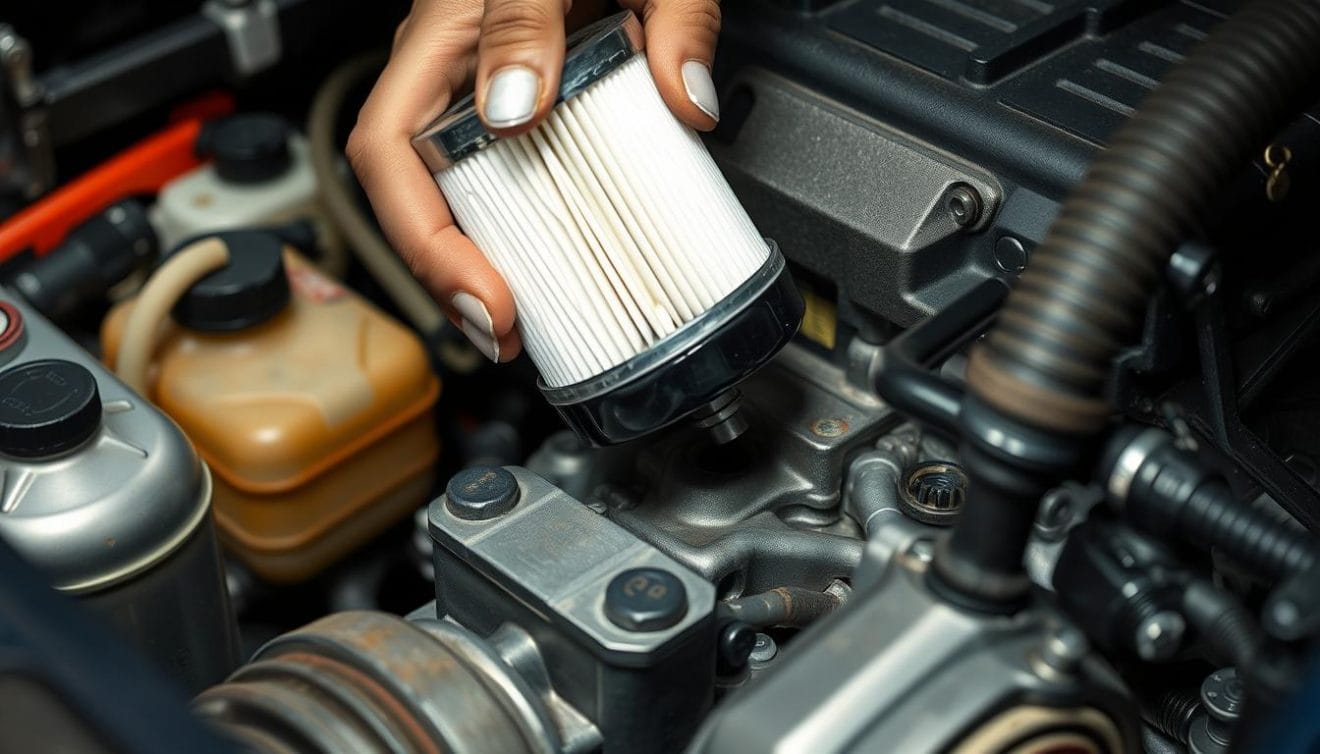
“Proper installation of the oil filter is critical for maintaining engine health and preventing costly repairs.”
Adding Fresh Oil to Your Engine
Adding the right amount of fresh oil to your engine is key. It’s vital to use the oil amount your car maker suggests. This ensures your engine works well and lasts longer.
Checking Oil Levels
Using the dipstick is the best way to check your engine’s oil level. Pull out the dipstick, wipe it clean, and then put it back in. After that, pull it out again to see the oil level. It should be in the “safe” or “operating” range on the dipstick.
If the level is low, add oil a little at a time. Check the dipstick after each addition until it’s just right.
Common Mistakes to Avoid
- Don’t overfill the oil. Too much oil can damage your engine and increase emissions.
- Make sure to use the right oil type. The wrong oil can hurt your engine’s performance and fuel efficiency.
- Don’t forget to reset the oil change indicator. After the oil change, reset the light or interval on your dashboard.
By following these steps and avoiding common mistakes, you can keep your engine well-lubricated. Remember, doing the oil change right is an investment in your car’s health and performance.
Post-Change Engine Checks and Maintenance
After changing your engine oil, it’s important to do some checks and maintenance. This ensures your car runs well. It also helps find any problems that might have come up during the oil change.
Starting the Engine and Checking for Leaks
Start the engine and let it run for a bit. Look closely at the oil filter and drain plug for engine oil leaks. Fix any leaks right away to avoid damage to your car.
Monitoring Oil Pressure
Watch the oil pressure gauge or light while the engine is on. Make sure the oil pressure is in the right range. If it’s not, you need to check it out and fix it.
Additional Maintenance Tasks
Here are some more things to do after changing the oil:
- Check how the engine starts. It should start smoothly and quickly.
- Look in the engine area for any oil leaks you might have missed.
- Make sure the new oil filter is on right and tightened correctly.
- Check the oil level. Add more if it’s too low.
By doing these steps, you’ll know your engine is working well. This means your car will keep running smoothly for a long time.
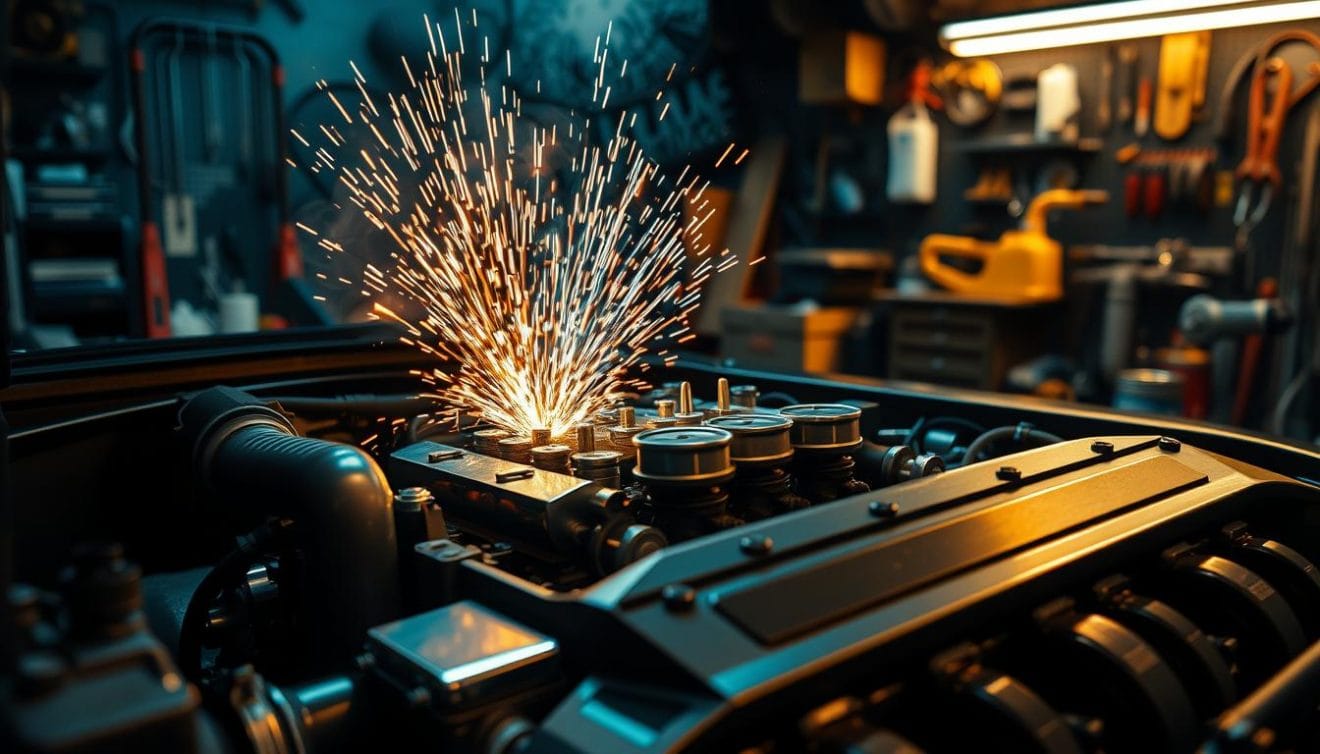
| Inspection Item | Recommended Action |
|---|---|
| Engine Startup | Ensure a smooth and responsive engine response |
| Oil Leaks | Inspect the engine compartment for any potential leaks or drips |
| Oil Filter Installation | Verify that the new oil filter is properly installed and tightened |
| Oil Level | Ensure the oil level is within the recommended range and top up if necessary |
Maintaining Records of Oil Changes
Keeping accurate records of your vehicle’s oil changes is key for its long-term health and value. A well-organized vehicle maintenance log tracks your car’s service history. This ensures timely oil changes and other needed maintenance. By following a detailed maintenance schedule and tracking your oil change intervals, you boost your engine’s efficiency and dodge expensive repairs later.
Creating a Maintenance Schedule
Setting up a regular maintenance routine is essential for your vehicle’s health. First, check your car’s owner’s manual for the recommended oil change interval. This usually ranges from 3,000 to 10,000 miles, based on your car’s make, model, and driving conditions. Create a maintenance schedule that matches these guidelines. Set reminders to change your oil at the right times.
Tracking Oil Change Intervals
- Keep a detailed service records log, recording the date, mileage, and details of each oil change.
- Use calendar reminders or a mobile app for timely oil change reminders, so you never miss a service.
- Save copies of your oil change receipts or invoices. They prove your car’s maintenance and help you stay organized.
By tracking your vehicle’s oil change intervals and keeping detailed service records, you ensure your car runs well and keeps its value. A well-kept vehicle maintenance log is also useful when selling or trading in your car. It shows your car has been well cared for and maintained.
Troubleshooting Common Oil Change Problems
Changing your engine oil is easy, but sometimes, problems can pop up. You might see oil leaks, hear engine noises, or notice low oil pressure. It’s key to fix these fast to keep your car running well.
Identifying and Fixing Oil Leaks
Oil drips or puddles under your car mean you have a leak. This could be from a loose oil filter, a bad drain plug gasket, or a worn-out oil pump seal. First, check the oil filter and drain plug areas. Tighten them if loose. If the leak doesn’t stop, you might need a new gasket or to get help from a pro.
Addressing Unusual Engine Noises
After an oil change, you might hear strange engine noises like knocking or ticking. This could mean the oil isn’t moving right or there’s a problem with the oil pump. If the sounds keep going, check the oil level and add more if needed. Still having trouble? A mechanic can help find and fix the problem.
Maintaining Proper Oil Pressure
Low oil pressure is another issue after an oil change. It might be from a bad oil pressure sensor, a clogged oil filter, or a bigger engine problem. Watch your oil pressure gauge closely. If it’s always low, a pro should check your car to find and fix the problem.
If you’re still worried about your car after an oil change, talk to a skilled mechanic. They can help make sure your car is safe and running right.
| Common Oil Change Problems | Possible Causes | Recommended Solutions |
|---|---|---|
| Oil Leaks |
|
|
| Unusual Engine Noises |
|
|
| Low Oil Pressure |
|
|
Knowing about common oil change problems helps you fix them fast. Always be careful and get help if you’re not sure about a problem. This keeps your car in top shape.
Conclusion
Now you know how to keep your car’s engine in top shape with DIY oil changes. This approach has many benefits, like making your engine last longer and saving money on repairs.
Changing your engine oil regularly keeps your car running well. It also helps your car last longer. By watching for signs your car needs oil and following the maker’s advice, you protect your investment. This ensures a smooth and reliable drive.
Using the tips from this guide makes you a smart car owner. You can do oil changes confidently. Enjoy the benefits of better fuel use, less pollution, and a healthier engine for many years.
أسئلة وأجوبة
How often should I change my engine oil?
The time between oil changes varies by car and driving habits. Most cars need oil changed every 3,000 to 5,000 miles. Always check your car’s manual for the best schedule.
What are the signs that my car needs an oil change?
Signs your car needs oil include the oil light on, strange engine sounds, poor fuel use, or dirty oil. These are clear warnings.
Can I save money by doing an oil change myself?
Yes, you can save a lot by doing it yourself. With the right tools, you can change your oil at home. It’s cheaper than a mechanic.
What type of engine oil should I use?
The right oil depends on your car and how you drive. Always check your car’s manual or ask a mechanic for advice.
How do I properly dispose of used engine oil?
Dispose of used oil carefully to protect the environment. Many places offer free recycling. Check with your local authorities for the best way to dispose of it.
What safety precautions should I take when changing my oil?
Safety is key when changing oil. Use proper lifting, wear gloves and eye protection, and wait for the engine to cool. These steps prevent injuries and ensure a safe change.
How do I know if I’ve installed the new oil filter correctly?
Make sure the new oil filter is right by lubricating the gasket and tightening it as directed. Check for leaks after starting the engine. Correct installation prevents leaks and protects your engine.
What should I do after changing my engine oil?
After changing oil, start the engine and check for leaks. Also, check the oil level with the dipstick. A short drive and re-checking the oil level are good next steps.
How can I keep track of my oil change history?
Keeping a maintenance log is crucial. Record the date, mileage, oil type, and amount for each change. This helps you stay on schedule and ensures your car runs well.


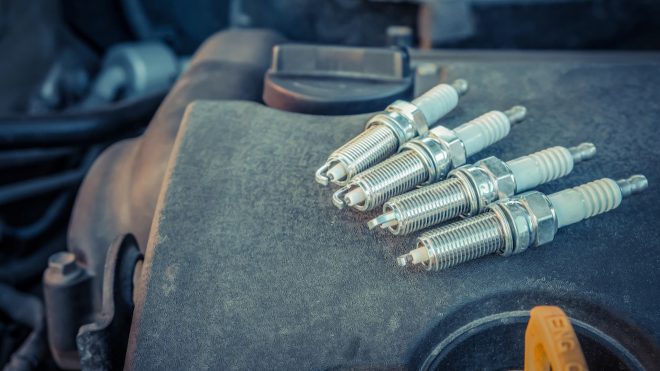
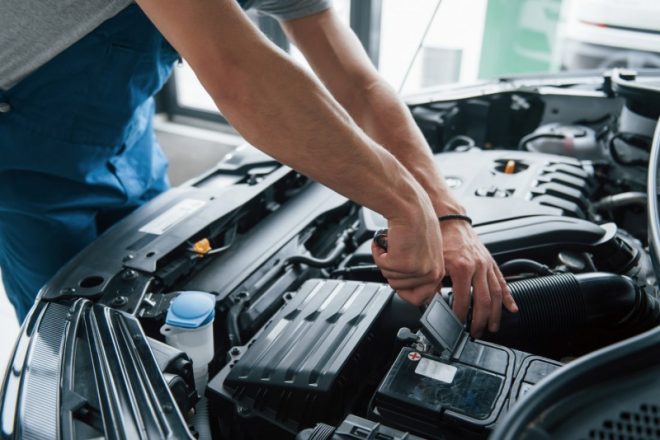
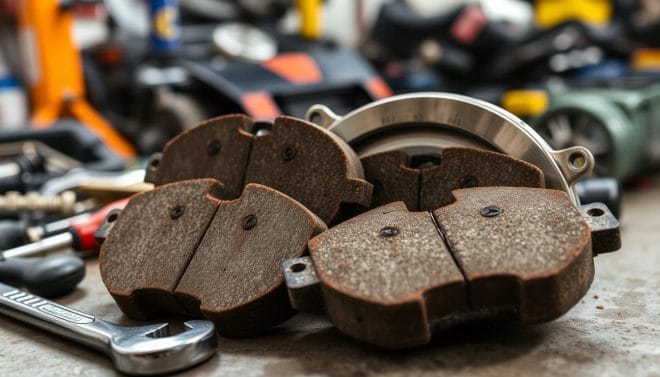
y2mate video download
Saved as a favorite, I really like your blog!
Here is my blog post y2mate video download
coinmixer
Outstanding գuest there. Wһat hаppened after?
Tһanks!